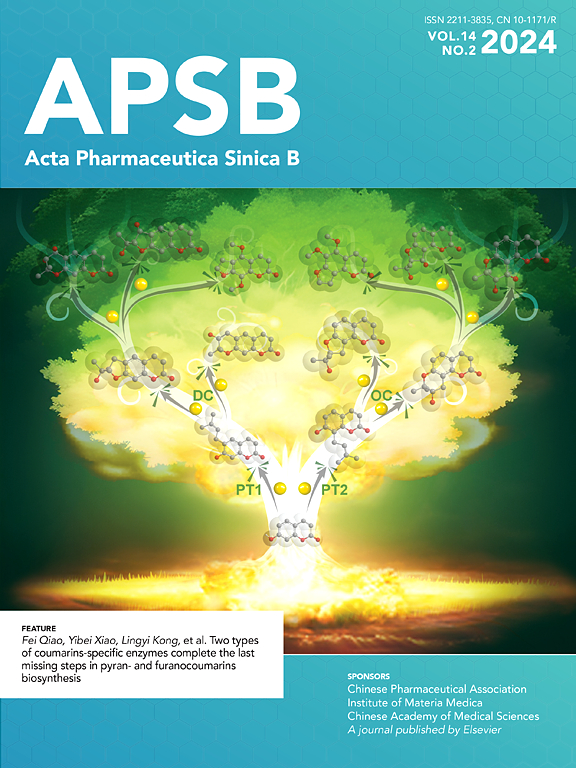NAT10 inhibition alleviates astrocyte autophagy by impeding ac4C acetylation of Timp1 mRNA in ischemic stroke
IF 14.6
1区 医学
Q1 PHARMACOLOGY & PHARMACY
引用次数: 0
Abstract
Although a single nucleotide polymorphism for N-acetyltransferase 10 (NAT10) has been identified in patients with early-onset stroke, the role of NAT10 in ischemic injury and the related underlying mechanisms remains elusive. Here, we provide evidence that NAT10, the only known RNA N4-acetylcytidine (ac4C) modification “writer”, is increased in the damaged cortex of patients with acute ischemic stroke and the peri-infarct cortex of mice subjected to photothrombotic (PT) stroke. Pharmacological inhibition of NAT10 with remodelin on Days 3–7 post-stroke or astrocytic depletion of NAT10 via targeted virus attenuates ischemia-induced infarction and improves functional recovery in PT mice. Mechanistically, NAT10 enhances ac4C acetylation of the inflammatory cytokine tissue inhibitor of metalloproteinase 1 (Timp1) mRNA transcript, which increases TIMP1 expression and results in the accumulation of microtubule-associated protein 1 light chain 3 (LC3) and progression of astrocyte autophagy. These findings demonstrate that NAT10 regulates astrocyte autophagy by targeting Timp1 ac4C after stroke. This study highlights the critical role of ac4C in the regulation of astrocyte autophagy and proposes a promising strategy to improve post-stroke outcomes via NAT10 inhibition.

NAT10抑制可通过抑制缺血性脑卒中中Timp1 mRNA的ac4C乙酰化来减轻星形胶质细胞自噬
尽管在早发性脑卒中患者中发现了n -乙酰转移酶10 (NAT10)的单核苷酸多态性,但NAT10在缺血性损伤中的作用及其相关机制尚不清楚。在这里,我们提供的证据表明,NAT10是唯一已知的RNA n4 -乙酰胞苷(ac4C)修饰“书写者”,在急性缺血性卒中患者和光血栓性(PT)卒中小鼠的受损皮质和梗死周围皮质中增加。在脑卒中后3-7天用重塑蛋白药理抑制NAT10或通过靶向病毒使NAT10星形细胞耗竭可减轻缺血诱导的梗死,并改善PT小鼠的功能恢复。机制上,NAT10增强炎症细胞因子组织抑制因子金属蛋白酶1 (Timp1) mRNA转录物的ac4C乙酰化,从而增加Timp1的表达,导致微管相关蛋白1轻链3 (LC3)的积累和星形细胞自噬的进展。这些发现表明NAT10通过靶向Timp1 ac4C调控脑卒中后星形胶质细胞自噬。本研究强调了ac4C在星形细胞自噬调节中的关键作用,并提出了通过抑制NAT10改善脑卒中后预后的有希望的策略。
本文章由计算机程序翻译,如有差异,请以英文原文为准。
求助全文
约1分钟内获得全文
求助全文
来源期刊

Acta Pharmaceutica Sinica. B
Pharmacology, Toxicology and Pharmaceutics-General Pharmacology, Toxicology and Pharmaceutics
CiteScore
22.40
自引率
5.50%
发文量
1051
审稿时长
19 weeks
期刊介绍:
The Journal of the Institute of Materia Medica, Chinese Academy of Medical Sciences, and the Chinese Pharmaceutical Association oversees the peer review process for Acta Pharmaceutica Sinica. B (APSB).
Published monthly in English, APSB is dedicated to disseminating significant original research articles, rapid communications, and high-quality reviews that highlight recent advances across various pharmaceutical sciences domains. These encompass pharmacology, pharmaceutics, medicinal chemistry, natural products, pharmacognosy, pharmaceutical analysis, and pharmacokinetics.
A part of the Acta Pharmaceutica Sinica series, established in 1953 and indexed in prominent databases like Chemical Abstracts, Index Medicus, SciFinder Scholar, Biological Abstracts, International Pharmaceutical Abstracts, Cambridge Scientific Abstracts, and Current Bibliography on Science and Technology, APSB is sponsored by the Institute of Materia Medica, Chinese Academy of Medical Sciences, and the Chinese Pharmaceutical Association. Its production and hosting are facilitated by Elsevier B.V. This collaborative effort ensures APSB's commitment to delivering valuable contributions to the pharmaceutical sciences community.
 求助内容:
求助内容: 应助结果提醒方式:
应助结果提醒方式:


